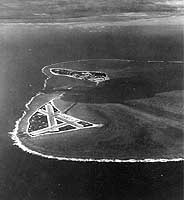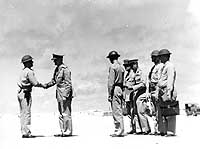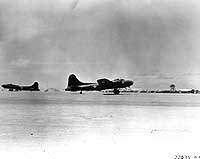
Midway is a small atoll nearly half-way across the Pacific, the westernmost inhabited member of the Hawaiian Island chain. Its two major islands, Sand and Eastern, have a combined area of only a few square miles. They are densely populated by several bird species, of which the most abundant is the Laysan Albatross, popularly nicknamed the "Gooney Bird".
First visited in 1859, Midway formally became a United States' possession in 1867. A trans-Pacific cable station was established there in 1903. In 1935, Pan American Airways built a way station on Sand Island to support its new seaplane route between the U.S. and Asia. Midway was recommended as a patrol plane and submarine base in a 1938-39 study of national defense needs, and construction of a U.S. Navy base began soon thereafter. This included a seaplane hangar and other facilities on Sand Island and an airfield on the smaller Eastern Island.
The new base was bombarded by two Japanese Destroyers on 7 December 1941, causing damage to some buildings and destroying one patrol plane. With the fall of Wake later in the month, Midway became the westernmost U.S. outpost in the Central Pacific. Land-based bombers and fighters were stationed on Eastern Island. U.S. Marines provided defensive artillery and infantry. Operating from Sand Island and the atoll's lagoon, PBY "Catalina" seaplanes actively patrolled toward the Japanese-held Marshall Islands and Wake, checking on enemy activities and guarding against further enemy attacks on Hawaii. There were occasional clashes when planes from Midway and those from the Japanese islands met over the Pacific.
Pacific Fleet commander Admiral Chester W. Nimitz inspected Midway in early May 1942, conferring with the local commanders, Navy Captain Cyril T. Simard and Marine Colonel Harold D. Shannon. As the Japanese threat to Midway became known during that month, Nimitz increased its ground and air forces, the latter to the point where Eastern Island was crowded with Marine Corps, Navy and Army Air Force planes. Several PT boats were sent to improve seaward defenses. By 4 June 1942, Midway was as ready as possible to face the oncoming Japanese.
This page presents views of Midway, and activities there prior to the start of the battle.
For artworks of Midway at this time, see the Navy Art Gallery
page:
For links to other images of preparations for the Battle
of Midway, see:
For links to views of other aspects of the Battle of Midway,
see:
| If you want higher resolution reproductions than the Online Library's digital images, see: "How to Obtain Photographic Reproductions." |
Click on the small photograph to prompt a larger view of the same image.
|
Photo #: 80-G-451086 Midway Atoll Aerial photograph, looking just south of west across the southern side of the atoll, 24 November 1941. Eastern Island, then the site of Midway's airfield, is in the foreground. Sand Island, location of most other base facilities, is across the entrance channel. Official U.S. Navy Photograph, now in the collections of the U.S. National Archives. Online Image: 127KB; 680 x 765 pixels Reproductions of this image may also be available through the National Archives photographic reproduction system. |
 |
|
Photo #: 80-G-6170 Second Lieutenant Francis P. McCarthy, USMCR of Marine Fighting Squadron 221 (VMF-221), at left Is congratulated by Admiral Chester W. Nimitz, Commander-in-Chief, Pacific, after he was presented with the Distinguished Flying Cross for his part in shooting down a Japanese Kawanishi Type 2 (H8K) flying boat near Midway on 10 March 1942. The ceremonies took place on Midway on 2 May 1942. Additional information is given in Photo # 80-G-6170 (complete caption). Official U.S. Navy Photograph, now in the collections of the U.S. National Archives. Online Image: 64KB; 740 x 575 pixels Reproductions of this image may also be available through the National Archives photographic reproduction system. |
 |
|
Photo #: USAF 22635 AC Battle of Midway, June 1942 U.S. Army Air Force B-17E "Flying Fortress" bombers take off from the airfield on Eastern Island, Midway Atoll, on 3-4 June 1942. Plane in the center is an early-model B-17E, with a Bendix remotely controlled belly turret. U.S. Air Force Photograph. Online Image: 50KB; 740 x 615 pixels Reproductions of this image may also be available through the National Archives photographic reproduction system. |
 |
For artworks of Midway at this time, see the Navy Art Gallery
page:
For links to other images of preparations for the Battle
of Midway, see:
For links to views of other aspects of the Battle of Midway,
see:
NOTES:
| If you want higher resolution reproductions than the Online Library's digital images, see: "How to Obtain Photographic Reproductions." |
Page made 24 April 1999
Coding updated 22 April 2009